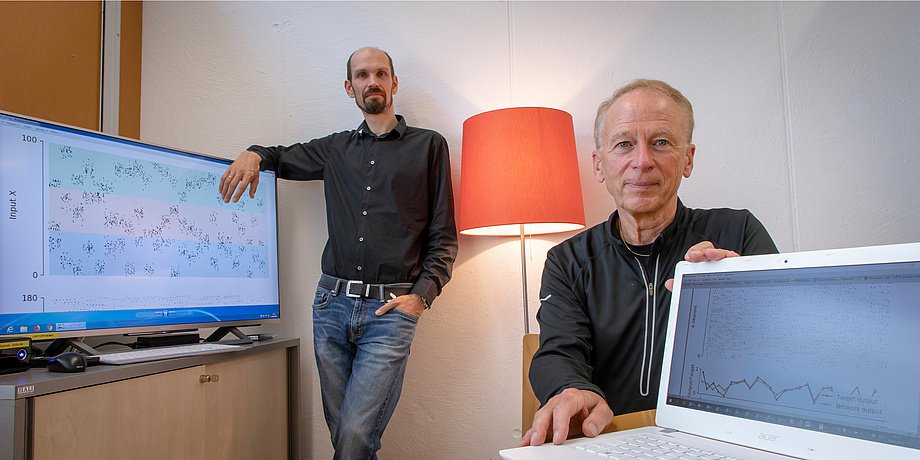New approach for a biological programming language
23 June 2020
In the Human Brain Project, Wolfgang Maass and his team investigate how taking inspiration from neural information processing in the brain could enable more efficient AI methods.

Photo © Lunghammer - TU Graz
Specifically, the researchers have succeeded in mathematically modelling the emergence and interaction between so-called "assemblies". These are neuron groups in the brain that form the basis for higher cognitive abilities such as thinking, imagining, arguing, planning or speech processing.
Better understanding of how the brain works
The Canadian neuroscientist Donald H. Hebb postulated as early as 1949 that neurons form such groups, in other words that they act together to encode individual words or symbols, as well as holistic "concepts". "However, the existence of assemblies has only become more consolidated in recent years, and our models are based on the latest results from brain research," explains Maass.
Assemblies are flowing entities that constantly reorganize themselves to process environmental stimuli, give them a symbolic meaning, structure them and transform them into knowledge. This adaptability – also called plasticity – provides the brain with the ability to get over its limited processing capacity and form an "unlimited" number of patterns.
The results not only contribute to a better understanding of the brain, they could also lead to efficient new AI methods as they combine the advantages of two main approaches to AI research: the symbolic and the connectionist.
Symbolic vs. connectionist information processing
Algorithms in symbol systems are based on defined rules (if/then commands) and logical formulas, and are persuasive through their ability to abstract: i.e. the ability to generalize and to apply general contexts to concrete facts. For this reason they are optimally suited for easy application to completely new situations. However, symbol-based systems must be programmed in a complex way and cannot be trained for demanding applications by means of large amounts of data, as is possible with neural networks. The latter consist of small, networked and adaptive computing units that are self-organizing and can quickly solve complex problems when working together. The learning ability of neural networks has made the connectionist approach more attractive for current AI research and for modern AI applications. However, neural networks have difficulties with tasks that did not occur in their training set.
"Human" brain architecture for machines
The assembly models presented now aim to combine the ability to abstract with the ability to learn. "These are neural networks that work symbolically with their assemblies. The paradigm we use is the human brain, which also combines both," said Legenstein.
Human Brain Project:

The Human Brain Project (HBP) is the largest brain science project in Europe and stands among the biggest research projects ever funded by the European Union. At the interface of neuroscience and information technology, the HBP investigates the brain and its diseases with the help of highly advanced methods from computing, neuroinformatics and artificial intelligence, and in turn drives innovation in fields like brain-inspired computing and neurorobotics. See humanbrainproject.eu
EBRAINS:
 As a lasting contribution to the global science community the HBP has developed EBRAINS, an open European research infrastructure that allows scientists and technology experts to seamlessly collaborate, accelerating advancements in the fields of neuroscience, computing and brain-related medicine. See https://ebrains.eu/
As a lasting contribution to the global science community the HBP has developed EBRAINS, an open European research infrastructure that allows scientists and technology experts to seamlessly collaborate, accelerating advancements in the fields of neuroscience, computing and brain-related medicine. See https://ebrains.eu/
Original Publications:
STDP Forms Associations between Memory Traces in Networks of Spiking Neurons
Cerebral Cortex, Volume 30, Issue 3, March 2020, Pages 952–968.
DOI: 10.1093/cercor/bhz140
A Model for Structured Information Representation in Neural Networks of the Brain
eNeuro 7 May 2020, 7 (3) ENEURO.0533-19.2020;
DOI: 10.1523/ENEURO.0533-19.2020
Brain computation by assemblies of neurons
Proceedings of the National Academy of Sciences Jun 2020, 202001893;
DOI: 10.1073/pnas.2001893117
Contact:
TU Graz | Institute of Theoretical Computer Science
Wolfgang MAASS
Em.Univ.-Prof. Dipl.-Ing. Dr.rer.nat.
Phone: +43 316 873 5822
maass@igi.tugraz.at
Robert LEGENSTEIN
Assoc.Prof. Dipl.-Ing. Dr.techn.
Phone: +43 316 873 58
legi@igi.tugraz.at



